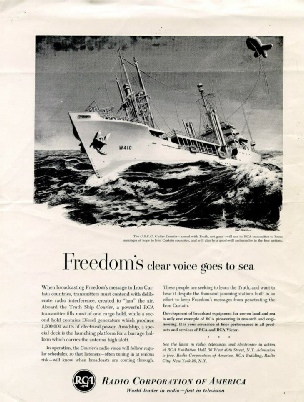© 2014-


Voice of America - History
Voice of America (VOA) is the official external broadcasting institution of the United States federal government. VOA provides a wide range of programming for broadcast outside the United States designed "to promote freedom and democracy and to enhance understanding through communication of accurate, objective, and balanced news, information and other programming about America and the world to audiences overseas.”
Voice of America used a number of military ships as offshore broadcasting bases, particularly during the 1940s and 1950s. In 1942 the USS Texas was anchored in the Mediterranean and equipped to broadcast Voice of America programmes as a counter to the many Nazi propaganda stations then on the air. These programmes, targeted at North Africa, commenced on 7th November 1942, coinciding with an Allied military advance in that area. However, some rapid Allied successes against the Nazi forces in North Africa meant that the station's mission became obsolete and transmissions were terminated after only a few weeks.
Three years later, in 1945, the Voice of America again used a ship, this time the Phoenix, anchored in the China Sea to broadcast propaganda programmes to the Far East on both shortwave and medium wave frequencies.
However, the most significant use of an offshore based transmitter by the Voice of America came in the early 1950s and was to serve as a role model for early European offshore commercial broadcasters.
Plans for a series of shipborne radio stations were first announced in April 1951 by the Department of State, in response to an initiative, code-
In late 1951/early 1952 a merchant ship, Coastal Messenger was converted, at a cost of $3.5million, into a floating radio station and renamed Courier. The station was fitted out by US Coastguards who installed three on-
President Harry S. Truman visited the Courier on 4th March 1952, when the ship docked in Washington, D.C. and he used the occasion to broadcast a major policy speech beamed at Eastern Europe and the Soviet Union.
In April 1952, during the Courier's trials in the Panama Canal Zone test broadcasts were made on shortwave and medium wave using the call sign KU2XAJ. The broadcasts closed with the playing of the Panamanian National Anthem and the Star Spangled Banner.
The broadcasts were made using an aerial held aloft by a helium filled balloon -
In August 1952, having s uccessfully completed test transmissions the Courier arrived in the Mediterranean and anchored off the Greek Island of Rhodes, commencing broadcasts as the Voice of America -
uccessfully completed test transmissions the Courier arrived in the Mediterranean and anchored off the Greek Island of Rhodes, commencing broadcasts as the Voice of America -
The Courier remained broadcasting at this base until May 1964, when the Voice of America’s operations were transferred to a landbased transmitter in Rhodes.
It was the successful operation of this ship-

Voice of America news report, June 2014, about an exhibition marking the 50th anniversary of the end of the Courier’s role as a floating radio station.
Part of an original VOA newsreel filmed in 1959 showing the radio station operations on board Courier.
(Narrated by Gregory Peck who was filming Guns of Navarone on the island of Rhodes at the time.)
A slide show presentation showing VOA operations on board Courier, with soundtrack from part of the station’s broadcasts

Click on picture to enlarge

History
Key Dates
Ship and Location
Technical
Staff




RCA used the Courier in an advert for its transmitters
Click to enlarge

Back to Voice of America


Back to Rest of the World Gallery
